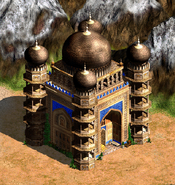Gol Gumbaz is an unconstructable building introduced in Age of Empires II HD: Rise of the Rajas.
Gol Gumbaz was originally the Wonder of the Indians beginning with Age of Empires II HD: The Forgotten. With Rise of the Rajas the Indians replaced the Middle Eastern architecture with the unique Vijayanagara-style architecture (now used by all Indian successor civilizations). With the change in architecture, Gol Gumbaz was replaced with the Brihadisvara Temple, located in modern-day Tamil Nadu, another state in South India. This was probably due to the fact the new Wonder fit better with the new architectural style, but also because Gol Gumbaz was anachronistic, as it was completed in the middle of the 17th century. It remains available in the Scenario Editor.
Campaign appearances[]
 Prithviraj[]
Prithviraj[]
- The Digvijaya: In the Definitive Edition, Gol Gumbaz served as the residence of the Lohara Raja, until it was replaced by the Gurjara Wonder in Dynasties of India.
 Victors and Vanquished[]
Victors and Vanquished[]
- Ironside: It serves as the Great Mosque of Cordoba in Qurtubah.
Gallery[]
| Buildings in Age of Empires II | |
|---|---|
| Civilian buildings | |
| Economic | |
| Research | |
| Religious | |
| Miscellaneous | |
| Military buildings | |
| Production | |
| Fortified production | |
| Tower | |
| Wall | |
| Scenario Editor buildings | |
| Bridge · | |



